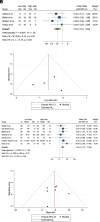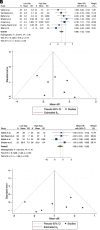Prognostic Value of PCO2 Gap in Adult Septic Shock Patients: A Systematic Review and Meta-Analysis
- PMID: 36301280
- PMCID: PMC9682943
- DOI: 10.5152/TJAR.2021.21139
Prognostic Value of PCO2 Gap in Adult Septic Shock Patients: A Systematic Review and Meta-Analysis
Abstract
Sepsis cases caused substantial mortality and a significant burden on healthcare costs and resources. To tackle this problem, there has been discussion surrounding O2 parameters as it has a distinct outcome in septic patients. This review aimed to evaluate the prognostic value of the central venous-arterial carbon dioxide difference (PCO2) gap in patients with septic shock. A comprehensive systematic search was performed through electronic databases including Pubmed, Scopus, and Embase for studies focusing on the use of PCO2 gap as a mortality predictor in septic shock patients. Other secondary outcomes such as mean arterial pressure, lactate clearance, the acute physiology and chronic health evaluation II score, and intensive care unit length of stay were also measured. The Newcastle-Ottawa Scale tool was used to assess the risk of bias. A total of 8 studies were analysed. The mortality rate (odds ratio=0.50, 95% CI=0.28-0.87, P < .01) and lactate levels (mean difference [MD] = -0.98; 95% CI=-1.62 to -0.35; P=.001) of the low PCO2 gap group were significantly lower than the high gap group. The low gap group had a significantly higher mean arterial pressure compared to the high gap group (MD=4.54; 95% CI=2.14 to 6.95; P=.001). There were no pronounced outcomes in acute physiology and chronic health evaluation score and intensive care unit length of stay. PCO2 gap can potentially be used as a marker for mortality rate in septic shock patients. It is also significantly associated with other predictors, such as mean arterial pressure and lactate clearance.
Figures





References
LinkOut - more resources
Full Text Sources
Miscellaneous
